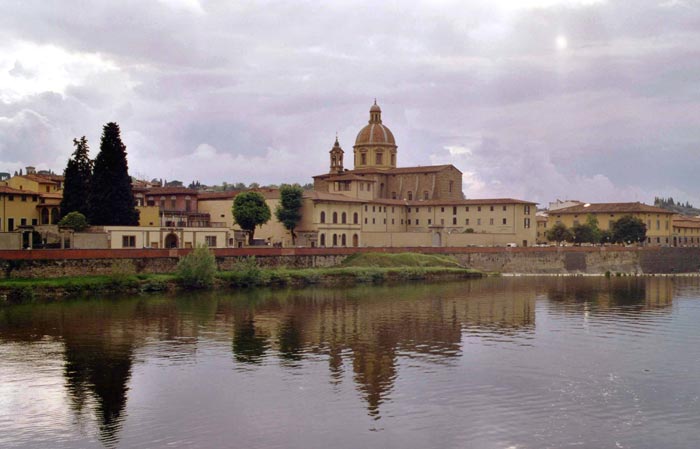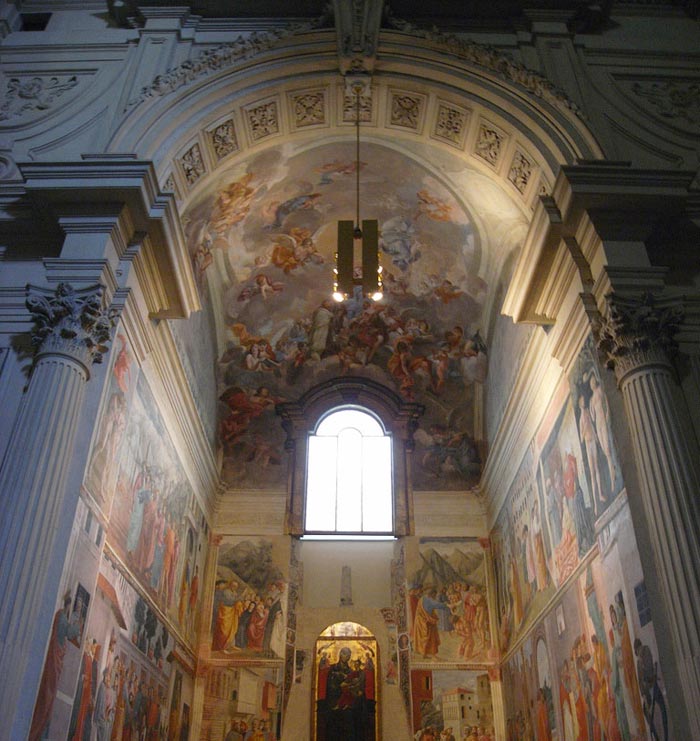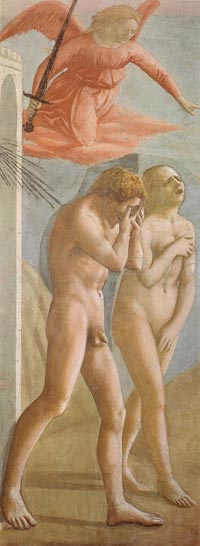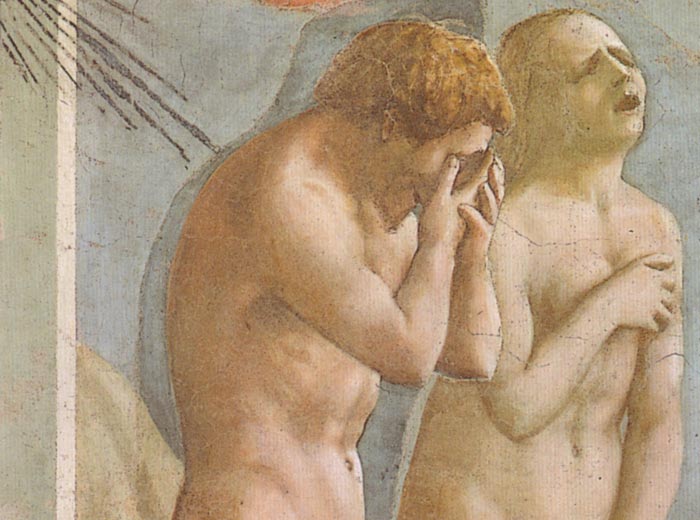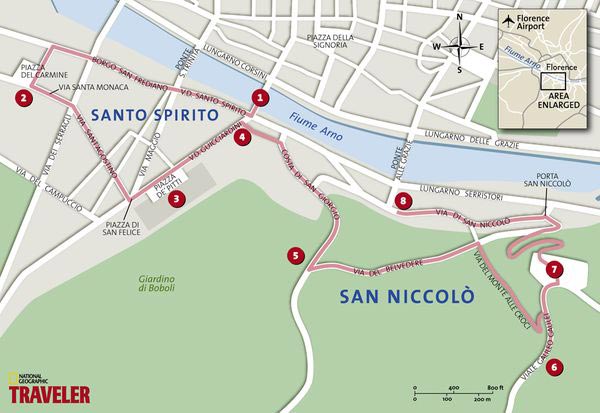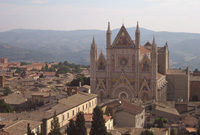| |
|
The foundation of the church dedicated to Our Lady of Carmel dates from 1268, but its construction was protracted until the end of the 15th century.
Little remains of the mediaeval building, not only because of the extensive 16th-century alterations but also because of a disastrous fire which gutted the church in 1771. What we see today is in large part the result of the late-baroque rebuilding carried out after the fire by Giuseppe Ruggieri. From that period date the paintings on the ceiling (Ascension of Christ) and in the dome (The Trinity and the Virgin in Glory with Saints of the Old and New Testament) by Giuseppe Romei and Domenico Stagi. The fire did not however affect the old sacristy, which still has its chapel with Scenes from the life of St Cecilia attributed to Lippo d’Andrea (c. 1400), the Brancacci Chapel in the right transept, or the Corsini Chapel in the left. The Brancacci Chapel has one of the supreme masterpieces of renaissance painting: the fresco cycle of Scenes from the life of St Peter, mostly painted in collaboration by Masaccio and Masolino between 1425 and 1427. The frescoes in the upper register are: Adam and Eve in the Earthly Paradise, and Original Sin by Masolino, and the Expulsion of Adam and Eve from the Earthly Paradise with the Tribute Money and the Baptism of the neophytes by Masaccio; also by Masolino are the Preaching of St Peter with the Healing of the lame man and the raising of Tabitha. In the lower register, Masaccio painted the two scenes on the end wall, St Peter curing the sick with his shadow and the Distribution of goods, with the death ot Ananias. The work was left unfinished by Masolino, who took off for Hungary, and by Masaccio, who decamped to Rome (where he died in 1428). Between 1435 and 1458, when the patron Felice Brancacci fell into political disgrace, the friars changed the dedication of the Brancacci Chapel to that of ‘La Madonna del Popolo’, moving the celebrated 13th-century Madonna and Child from the high altar into the chapel. It was perhaps on this occasion that part of Masaccio’s fresco with portraits of the Brancacci patrons was destroyed, a kind of damnatio memoriae. The chapel’s decoration was completed by Filippino Lippi, who between 1481 and 1485 worked on the lower register of the left wall, finishing the Raising of the son of Theophilus and St Peter enthroned which Masaccio had begun, and painting on his own St Peter in prison visited by St Paul on the adjacent pilaster. On the opposite wall he frescoed the Disputation of St Peter and St Paul with Simon Magus, and the Crucifixion of St Peter, and on the pilaster St Peter visited in prison. Between 1746 and 1748 the chapel was extensively redecorated: Vincenzo Meucci frescoed the ceiling with the Virgin consigning the Scapular to St Simon Stock, thus destroying Masolino’s Evangelists. At the same time the lunettes of the Shipwreck of the Apostles and the Calling of the Apostles were painted over.
The fire of 1771 also spared the Corsini Chapel, one of the jewels of the Florentine Baroque, built to contain the mortal remains of St Andrew Corsini (1301-74, canonised in 1629). Designed by the architect Pier Francesco Silvani, the chapel was decorated between 1675 and 1683 by Luca Giordano (frescoes in the dome, showing the Glory of St Andrew Corsini) and by Giovanni Battista Foggini (marble reliefs of St Andrew Corsini and the Battle of Anghiari, the Mass of St Andrew and the Apotheosis of St Andrew Corsini). Also saved was the marble funerary monument to Pier Soderini, by Benedetto da Rovezzano (1512-1513), placed inside the choir, behind the high altar.
Next to Santa Maria del Carmine stands the convent, rich in works of art. In the Room of the Column, looking onto the cloister, are displayed fragments of frescoes attributed to Pietro Nelli (c. 1385), other fragments from the Del Pugliese Chapel by Starnina (c. 1404), and a detached fresco of the Confirmation of the Rule by Filippo Lippi (1432). In the old refectory there is a Last Supper by Alessandro Allori (1582). In the second refectory there is the Supper in the house of Simon the Pharisee by Giovan Battista Vanni (c. 1645), and detached frescoes from the Nerli Chapel of Scenes from the Passion of Christ attributed to Lippo d’Andrea (1402).
Art in Tuscany | Masaccio | Brancacci Chapel in Santa Maria del Carmine, Florence
|
|
|
|
Masaccio, The Expulsion Of Adam and Eve from Eden, Brancacci Chapel, Church of Santa Maria del Carmine in Firenze
|
Located on one side of the entrance arch to the chapel, Masaccio’s Banishment depicts a hovering angel driving Adam and Eve from the gates of Paradise into a barren world. The calm countenance of the angel contrasts with the emotional anguish displayed by the fleeing Adam and Eve. Adam hides his eyes behind clutched hands, his mouth appears contorted, and his body contracts even as he strides forward into the unknown. Even though Eve’s gesture of hiding her genitals and breasts in shame is based on the classical sculpture of the Venus pudica, her strained eyes and open mouth convey a sense of real human suffering.
The painting demonstrates a new kind of naturalistic figural representation that was developing in contemporary sculpture, but had no precedent in painting. As Masaccio precisely renders the psychological turmoil of his figures, he also depicts their bodies with incredible delicacy, playing with light and shadow to reveal the contours of their forms.
Masaccio’s work represents the moment when Adam and Eve, having disobeyed God by tasting fruit from the Tree of Knowledge, lose their innocence, becoming suddenly aware of their naked bodies. Eve’s attempt to cover herself emphasizes her culpability in the Fall, while Adam conceals his emotional reaction, rather than his exposed body. During the conservative Counter-Reformation in Italy (ca. 1670), both figures were deemed inappropriate and their genitals were painted over with leafy branches. In the 1980s, during an extensive restoration, the frescoes were returned to their original state.
|
|
|
| |
|
Address: Piazza del Carmine
Open from 10 a.m. to 5 p.m. weekdays except for Tuesday, from 1:00 p.m. to 5 p.m. on weekends
Closed Tuesdays
Entrance fee € 4.00 (Cumulative ticket for the Cappella Brancacci and Palazzo Vecchio: € 8.00)

Art in Tuscany | Masaccio
Art in Tuscany | Masolino da Panicale
Art in Tuscany | Filippino Lippi
Bibliography
Damien Wigny, Au coeur de Florence : Itinéraires, monuments, lectures, 1990

[1] Tommaso Masaccio (c.1401-28) was an Italian 15th century Early Renaissance painter. Tommaso Cassai (full name Tommaso di Ser Giovanni di Mone Cassai) is known to us by his nickname "Masaccio", which is a diminutive of "Tommasaccio", the Italian for something like "big ugly Tom".
Masaccio died at the early age of 26 or 27 but managed to paint a few pictures of such enormous impact as to affect not only the whole future course of Florentine painting but also that of European fine art painting in general. As a result, he ranks alongside the architect Filippo Brunelleschi (1377-1446), the sculptor Donatello (1386-1466) and the architect and art theorist Leon Battista Alberti (1404-72) as one of the founding fathers of Renaissance art.
He was born at Castel San Giovanni, the modern San Giovanni Valdarno, located in the upper Arno valley, some 28 miles from Florence. Masaccio's father was a young notary, his mother, Mona Jacopa di Martinozzo, the daughter of an innkeeper from a nearby town.
Apart from what can be gleaned from his pictures, little extra is known of Masaccio's life. From documents it is known that in January 1422 he became a member of the Florentine painters' guild, the Arte de' Medici e Speziali, while living in the parish of San Niccolo Oltrarno. In 1424 he joined the Compagnia di San Luca, to which painters often belonged, while eight payments towards an altarpiece painted for the Carmelite church in Pisa attest to the fact that he was in that city during much of 1426, that he knew Donatello, and employed Andrea di Giusto. In 1427 Masaccio made a tax declaration to the newly instituted Catasta: he was then living in what is now the Via dei Servi and had his workshop near the Badia. This same source gives us the approximate date of his death: next to his name for the returns of 1429 is written, "Dicesi e morto a Roma", that is: "He is said to have died in Rome".
Nothing is known of Masaccio's art training. The apprentice system was such that he was probably learning a trade as early as 1410. This may have begun in a local painter's studio, or else in a family workshop. Or he may have been sent to train in a battega in Arezzo, in Florence, or elsewhere - but there is no evidence to show his early training was necessarily in the painter's craft.
Masaccio's earliest known surviving painting, an altarpiece of the Madanna and Child with Two Angels and Four Saints (1422; from S. Giovenale di Cascia, near S. Giovanni; now in the Uffizi, Florence) does give us some idea of what his training as a painter must have been. Masaccio was 20 years old when this picture was dated. It shows us that he is already interested in space: not only do the lines in the floor indicate an attempt to grasp the laws of linear perspective, but so does the structure of the throne, with its slanted sides and curved back. The sense of space is heightened both by the apparent modeling of the robes and faces and by the use of alternating light and dark colour in painting.
Wherever Masaccio trained, it can hardly have been in the strongly International Gothic atmosphere prevalent in Florentine painting in the first two decades of the 15th century, where a sinuous elegant surface line was more important than depth within the picture. On the contrary his interest in modeling, in flesh tones, in space, and in light is much more characteristic of Marchigian painters. Both Arcangelo di Cola da Camerino (fl.1416-22) and Gentile da Fabriano (c.1370-1427) show a keen interest in these things, and both were in Florence, the former about 1419-22, the latter first in 1419-20 and then again in 1422-5. It is possible that Masaccio was influenced by one or both of them. There is also one Florentine painter who shows much of Masaccio's interest in modeling and space, Giovanni Toscani, and it is conceivable that Masaccio was one of his pupils. Other possible masters to Masaccio were Bicci di Lorenzo and Francesco di Antonio. Masolino, who came from near San Giovanni, and with whom Masaccio worked on at least three commissions, was almost certainly not Masaccio's master: he may have hired Masaccio to help him with important commissions, but it was the much younger painter, Masaccio, who then influenced his senior.
The whole of Masaccio's authenticated extant work, besides the San Giovenale painting, derives from only five other commissions: the so-called "Matterza" Madonna and Child with St Anne (c.1424; Uffizi Gallery Florence); the Pisa Altarpiece (panels now dispersed); a fresco of The Trinity in S.Maria Novella, Florence; frescoes in the Brancacci Chapel, S.Maria del Carmine, Florence; and Saints Jerome and John the Baptist from an altarpiece originally in S.Maria Maggiore, Rome.
The first of these paintings, the Uffizi Madonna and Child with St Anne, was executed with the help of Masolino c.1424 for the church of S.Ambrogio in Florence. Masolino painted St Anne, plus all the angels except the middle one on the right; Masaccio did the Virgin, Christ Child, and remaining angel. In spite of the difference between Masolino's more orthodox approach and Masaccio's strong volumes, the picture is remarkably harmonious. Masaccio has placed his Madonna extremely low, emphasizing the light and shade falling on her knees, on the folds in her robes, and on the Infant Christ. As in the S.Giovenale painting, he has painted the Christ Child nude; but here the figure seems so solid and is so Classical in flavour that the painter must have drawn it after an antique statue. There are, in fact, many extant antique statues of babies in just this pose.
The chronology of the other known works is not clear, although they seem all to have been painted between 1425 and the artist's death, probably some time in 1428. It seems possible that Masaccio painted The Trinity in S.Maria Novella, Florence, in 1425 or 1426, perhaps for the feast of Corpus Domini in one of those years, although stylistically the painting is so advanced that it may well date after the painter's earliest work in the Brancacci chapel. Masaccio probably helped Masolino to plan the frescoes in the Brancacci Chapel in S.Maria del Carmine during 1425, and then began himself to paint there some time after Masolino's departure for Hungary in September of the same year. Masaccio must have worked at them during 1426, as well perhaps as during 1427. The Pisa Altarpiece is, as mentioned above, dated to the year 1426; while the panel of Saints Jerome and John the Baptist (National Gallery, London) from the S.Maria Maggiore altarpiece was probably painted during Masaccio's trip to Rome in 1427/28.
Masaccio's Themes | From the converging lines of the San Giovenale triptych, right through all his subsequent works, Masaccio developed two themes that were to remain central to the idiom of the Renaissance and to the history of Western painting. The first is the successful portrayal of a natural world within the painting, with convincing space, light, air, and objects. The second is part of this, but at the same time independent of it: the portrayal of a convincing replica of man, who dominates and gives order to that world. This is, of course, a visual version of the more general search for a correct scientific definition of man's place in the natural world, which occupies the Renaissance in all its facets.
Masaccio's Trinity terminates the Middle Ages by expressing the essence of medieval Christian belief in Renaissance terms. His work The Tribute Money in the Brancacci Chapel, on the other hand, stands clearly beyond the threshold, in the light-filled world of the Renaissance.
Nothing could be more traditional to the Christian age than Masaccio's Trinity theme of a predominant God the Father, supporting his crucified human Son, joined by the white dove of the Holy Spirit: the universal, the human, the spiritual. But nothing could be less traditional in its expression. Vaulted by a magnificent Renaissance triumphal arch, the divine trio appears almost suspended before a pierced wall. This coffered Brunelleschian space seems to be a mortuary chamber, a holy sepulchre from which the Christ is shown resurrected by His Father, Saviour to a waiting world, presented by the Virgin and St John; this world is symbolized by the two donors just outside. The worldly spectator is also included in the painting by association with the skeleton under the altar; unlike the human body of Christ, which rose intact, our worldly bodies decay. Above the skeleton are written some words to warn the passer-by; "I was that which you are, you will be that which I am". Inside the sepulchre, the space has been constructed according to the laws of linear perspective, so that the eye appears to be looking into the interior of a magnificent Renaissance building.
Masaccio set the background to The Tribute Money, in the Brancacci Chapel at S.Maria del Carmine, in a light-filled landscape, dominated (as is the countryside at San Giovanni Valdarno) by high hills. The painter, using newly established laws of perspective, created an infallible illusion of air, light, and space. But whereas in The Trinity God is the theme, here it is Man who dominates. Masaccio places in the natural scene classical statuesque figures, also apparently modelled after the Antique, who are above all human and free to move within their own natural world.
The Tribute Money emerges as, historically, the most important single picture in Florence today. Each individual in the painting stands, for the first time, strong and solitary, on a natural and benevolent earth, sustained by real air, bathed in light, master of the world stretching all around. Masaccio threw off the gloom and mystery of earlier times, resurrecting the forms of an ancient pre-Christian world. In the painting Christ stands equal to Man, not dominating him: a human being Himself, giving good advice to His followers. In The Tribute Money we already witness a Reformation - clearly evident too in the humanistic work of Donatello and Brunelleschi - in which Man does not cease to believe in Christ, although he may cease to believe in the infallibility of the Roman Church. Rather, Man ceases to believe in a triumphal Christ-God and begins to believe in a human Christ-Man.
Brancacci Chapel Frescos | The fresco paintings in the Brancacci chapel, of which The Tribute Money is one, relate scenes from the life of St Peter. The whole cycle seems to have been begun by Masolino about 1425, and then continued by Masaccio. The chapel was not actually finished until much later in the 15th century, by Filippino Lippi. The Tribute Money itself alludes in some way to Man's separate duties to the State and to the Church. In it St Peter is instructed by Christ to pay a tax to the civil authority. This must certainly be a reference to the obligations of the Roman Church towards secular authority; it probably also refers to each individual man's obligation to render separately to God and to Caesar that which is due to them.
The other paintings by Masaccio in the chapel seem to confirm this message: St Peter is seen preaching, baptizing, healing, and distributing alms: all corporal works of mercy. What then is the meaning of Masaccio's stupendous fresco of The Expulsion from Paradise on the entrance arch to the chapel? Perhaps Masaccio meant simply to point out that the anguish of Man over his loss of paradise can be solaced by the good works of Holy Mother the Church; the Church is the source of grace, through which Man can be saved.
The only two other extant, autograph works by Masaccio have already been mentioned: the various panels from the Pisa polyptych, and the panel of Saints Jerome and John the Baptist from Masolino's S.Maria Maggiore altarpiece. The former group includes the strongly rendered Madonna and Child with Four Angels, now in London's National Gallery, the central panel of the original altarpiece. Here, even within the most traditional late medieval schema, the painter introduces strong volumes for the Madonna's robes, and space all around the throne.
Above all else, he introduces the greatest innovation of Renaissance painting: light defined as coming from a single source, by the shadows it casts. In this painting too, one is aware of the great sensitivity and delicacy of the painter's brushwork - the angels playing lutes are of such simplicity and craftsmanship as to make them seem to sing. Two other remarkable paintings from this altarpiece are the small panels of the Crucifixion now in Naples (Museo e Gallerie Nazionali di Capodimonte), and the Nativity in Berlin (Staatliche Museum). In the former the animal-like figure of the crouched Magdalene gesturing towards the anguish of St John and of the Virgin is of such a simple expressive force as almost to defy analysis. Christ's stark, shadow-struck body, meant to be seen from below, is also intensely expressive. As for the small Nativity panel, its lifelike Kings, the animals, the Holy Family - all are bathed in a dawn light, clearly defining the spaces involved, throwing sharp shadows.
The London panel of Saints Jerome and John the Baptist was once part of a triptych painted on both sides for the Roman basilica of S.Maria Maggiore. This painting, which represents the founding of that church, flanked by saints, is predominantly by Masolino; for some unknown reason, however, Masaccio executed this one panel. Since Masaccio and Masolino worked together on the Uffizi Madonna, in the Brancacci Chapel, as well as perhaps in other places, it is not so surprising that they collaborated here too.
Artistic Legacy | Masaccio's contribution to the development of Western painting is enormous. During the first two decades of the 15th century, both sculpture (primarily through the work of Donatello) and architecture (through that of Brunelleschi) began to be cast in a new Renaissance idiom. In the course of a few years during the 1420s, Masaccio managed to set Western painting on a Renaissance course, similar in essence and language to that taken by those other expressions. If Giotto di Bondone (1267-1337) had created, over a century earlier, an ideal world in which Christian myths were acted out, Masaccio secularized that world by filling it with space, light, and air, and by placing a Classical sort of man within it, surrounded by nature. This idea of man as central to a logical natural world, and master of it, was to remain the principal source of imagery for Western painting until very recent times.
[2] Masolino da Panicale (1383-1440) | Like several of the great Old Masters, it is likely that Masolino (Tommaso di Cristofano Masolino da Panicale) was a goldsmith in his youth - in any case, according to Giorgio Vasari, he was the 'best worker in bronze'. Certainly it was to him that Lorenzo Ghiberti turned while working on the south door of the Baptistery in Florence. He was not admitted to the guild of the Mediei e Speziale in Florence until 1423, the year in which he added his name to the Madonna of Humility (Bremen Museum), a work which bears few similarities to Ghiberti. In fact he uses a suppler, broader line, a freer construction, less calculated and less academic than Ghiberti's. But his qualities as a painter emerge particularly in his use of delicate but intense colours, and of textures which grow denser in the shade, then blur and soften in lighter areas in order to avoid too heavy an insistence on the difference between light and shade. At the same time, he knew how to convey the essential quality of things, as Giovanni da Milano had before him.
This colourful, tender vision had its origins in the International Gothic style as practised in Tuscany by Lorenzo Monaco and to an even greater extent by artists such as the 'Master of the Strauss Madonna', and the 'Master of the Bambino Vispo'. It also included certain features new to Florence, such as the fantasies of Arcangelo di Cola (who came to Florence in 1419) and Gentile da Fabriano (1422).
Early Work: International Gothic Style | On 2nd November 1424 Masolino finished the fresco painting in the chapel of the Confraternity of the Cross (or of S. Elena) in the Church of S. Agostino d'Empoli, of which today only the sinopia (reddish-brown pigment) remains, together with a few decorative fragments and the Saints from the intrados of the entrance arch. In a lunette from another part of the church, important remains of a Madonna and Child with Two Angels and the fragments of a group of Young Girls at Prayer seem to pre-date the decoration of the chapel and even the Bremen Madonna. Because of its obvious similarities with Lorenzo Monaco and the 'Master of the Bambino Vispo', the Madonna from the Contini-Bonacossi collection in Florence (now in the Palazzo Vecchio), with its exceptionally broad range of colours, both vivid and delicate, would appear to be even earlier. It undoubtedly represents the high point of Florentine painting in the International Gothic style.
Working With Masaccio | The Heads which survive from the chapel of the Cross at S. Agostino d'Empoli, on the other hand, are very similar to the Bremen Madonna, although a few of them reveal a more synthetic and more sharply defined chiaroscuro that recalls the earlier collaboration between Masolino and Masaccio on The Virgin with St Anne (Uffizi, Florence). In this latter work the monumentality of the Madonna and the massive form of the Child reveal the hand of an artist impatient to bring his new ideas to fruition, and unconcerned with Masolino's careful experiments within the framework of Gothic art. It has been established that Masaccio painted the figures of the Madonna, the Child and the angel in the top right-hand corner, while Masolino was responsible for St Anne and the other angels.
With the aid of this identification it has been possible to clarify the respective contribution of each artist to a further collaboration between them, the decoration of the Brancacci chapel in the Church of S. Maria del Carmine in Florence, commissioned by Felice Brancacci from Masolino, shortly after the former's return to Florence in February 1423. During the 18th century, the vault was unfortunately repainted and a huge altar was installed against the rear wall. To Masolino may be attributed The Temptation of Adam and Eve on the pilaster to the right of the entrance. The Resurrection of Tabitha (except for the square and the buildings in the background) and The Sermon of St Peter on the rear wall. Adam and Eve Expelled from the Garden of Eden on the left-hand pilaster by the entrance, and The Tribute Money (with the exception of the head of Christ) on the left wall, as well as The Baptism of the Neophytes, are the work of Masaccio. Compared to his colleague, Masolino (whose dealings with the Church of S. Maria del Carmine are proven by documents dated 1425) seems to give his figures a more ample and monumental stature and to highlight their volume by the deliberate use of chiaroscuro. But he failed to achieve the desired effect and the shading of the faces looks more like sunburn.
He undoubtedly obtained his best effects in the fresco of the Pieta, even though it is a little heavy (now in the museum of the Collegiate Church of Empoli) and in the Carnesecchi Triptych of the Florentine church of S. Maria Maggiore, of which only the right-hand panel depicting St Julian (Florence, Seminary) now survives, although there is a panel from the predella in Montauban Museum. Here, Masolino uses a more filtered, diffuse chiaroscuro (clothing, head of the Christ-Child, left hands of the Virgin and of St Julian) and the result suggests a gentler, mellower Masaccio. The triptych was almost certainly in position by 1426 and must have been executed before 1st September 1425, when Masolino left for Hungary.
Masolino returned to Italy in July 1427. Between 1427 and 1431 he finished in Rome the frescoes in a chapel in S. Clemente (Scenes from the Lives of St Catherine and St Ambrose, Annunciation, Crucifixion, Evangelists, Doctors of the Church) and the double-sided triptych for the Church of S. Maria Maggiore.
Attribution Difficulties | But here too the presence of Masaccio complicates analysis of the work. In fact, he was responsible for Saints Jerome and John the Baptist (London, N.G.) in the polyptych and probably had a hand in the execution of the soldiers in the bottom left-hand corner of the S. Clemente Crucifixion. A certain difference in style between the panel paintings executed by Masolino himself suggests that he and Masaccio had already paid a visit to Rome in 1425. The Crucifixion ensemble is exceptionally sober and deep compared with the other scenes, such as that showing the Beheading of St Catherine, which reveals a marked tendency towards the anecdotal. The panel of the polyptych with St Matthias and a Pope (St Liberius) (London, N.G.) is closer in style to the frescoes of the Brancacci chapel than to the refined, elegant central scenes of the S. Maria Maggiore altarpiece (Naples, Capodimonte).
This hypothesis is further strengthened by the fact that in April of 1425 Cardinal Castiglione, who commissioned works from Masolino and who was the titular cardinal of the Church of S. Clemente, passed through Florence. In Rome, too, he was associated with Cardinal Brancacci, the brother of Felice, who had commissioned the decorations for the chapel of S. Maria del Carmine. After executing around this time The Madonna of Humility (Munich, Alte Pinakothek) and the two Annunciations (Washington, N.G.), in 1432 Masolino painted for the Church of S. Fortunato in Todi, a fresco of the Madonna between Two Angels, which is close in style to the admirable fresco cycle in the Baptistery of Castiglione Olona (Scenes from the Life of St John the Baptist, Evangelists, Doctors of the Church, God the Father). These were certainly carried out before those of the vault of the collegiate choir (Scenes from the Life of the Virgin), finished by Paolo Schiavo and by Vecchietta, probably after the death of the painter.
Revised Version of Masaccio's Aesthetic | Here, such elements as the influence of the late International Gothic, the experience of the innovative Early Renaissance painter Masaccio, a sure knowledge of perspective and the new outlook of Gentile da Fabriano are blended into a cheerful and colourful vision of men and of things, of architecture and landscape, depicted in a range of clear, vivid colours. The artistic heritage left by Masolino served as a basis for a revised version of Masaccio's aesthetic, as applied later by Domenico Veneziano and Piero della Francesca.
|

Tuscan Holiday houses | Podere Santa Pia
|
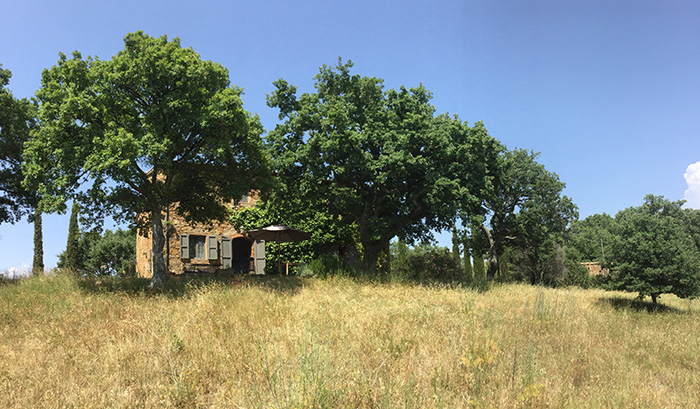 |
Podere Santa Pia is situated in the unspoiled valley of the Ombrone river, in southern Tuscany
|
| |
|
|
|
|
|
| |
|
|
|
|
| www.museumsinflorence.com | Brancacci_chapel
|

The Oltrarno and San Miniato
The Oltrarno — literally “across the Arno” — stands apart from Florence’s busy central and eastern quarters. Traditionally a blue-collar district, it retains a peaceful and workaday atmosphere, full of artisans’ studios, antiques stores, bars, and small restaurants. At the same time it features plenty of historic sights, not least the art-filled Palazzo Pitti and the church of San Miniato al Monte.
Start your walk at the (1) Ponte Vecchio, a picturesque bridge that dates from around 1345. Across the river, turn at the second right and follow Via di Santo Spirito and Borgo San Frediano to (2) Santa Maria del Carmine in Piazza del Carmine. The church is known for the Cappella Brancacci and Masaccio and Masolino’s pioneering early Renaissance frescoes (begun 1424).
From the east side of the piazza in front of the church take Via Santa Monaca and Via Sant’Agostino to Piazza di San Felice and Piazza de’ Pitti. The latter is home to the (3) Palazzo Pitti (www.palazzopitti.it), a vast former Medici palace that contains several galleries, including the standout Galleria Palatina.
Walk north out of the piazza on Via de’ Guicciardini and visit the church of (4) Santa Felicita in Piazza di Santa Felicita. This is one of Florence’s oldest churches, built on the site of a fourth-century basilica. Inside, it contains paintings dating to the 1500s by Jacopo Pontormo, known for his vivid use of color and unsettling compositions.
To the east and behind the church, take Costa di San Giorgio, a pretty lane that climbs steeply, with the former home of the scientist Galileo near the top at No. 19. Just beyond the house on the right at Via del Forte di San Giorgio is the entrance to the (5) Forte del Belvedere, a 16th-century fortress that formed part of the city’s outer defenses.
Turn left on Via del Belvedere, which follows part of the old city walls and offers lovely views to the Tuscan hills. At the bottom of the hill turn right on Via del Monte alle Croci.
At this point, Jonathan Buckley, co-author, The Rough Guide to Florence & Siena, recommends stopping for a drink and a breather at the wine bar-osteria Fuori Porta (Via del Monte alle Croci 10R; tel. 39 055 234 2483. www.fuoriporta.it).
Then turn almost immediately left up the stepped Via di San Salvatore al Monte. At Viale Galileo Galilei, turn right and walk up the steps to the 11th-century church of (6) San Miniato al Monte.
San Miniato is one of Tuscany’s finest Romanesque buildings. Highlights in the interior include the pulpit, screen, apse mosaic (from 1297), and the beautifully decorated Cappella del Cardinale del Portogallo.
You can catch a bus back to the city center from Viale Galileo Galilei or walk to (7) Piazzale Michelangelo just north of San Miniato. Enjoy the sweeping city views from the piazzale; then follow the path off its left (west) side down to Porta San Niccolò. Turn left here on Via di San Niccolò to the (8) Museo Bardini in Piazza de’ Mozzi, an unsung but enticing and eclectic collection of art and artifacts.
|
|
|
|
|
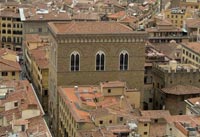 |
|
 |
Orvieto, Duomo |
|
Florence, Orsanmichele |
|
Florence, Duomo Santa Maria del Fiore |
| |
|
|
|
|
| |
|
|
![]()
![]()
![]()
![]()
![]()

